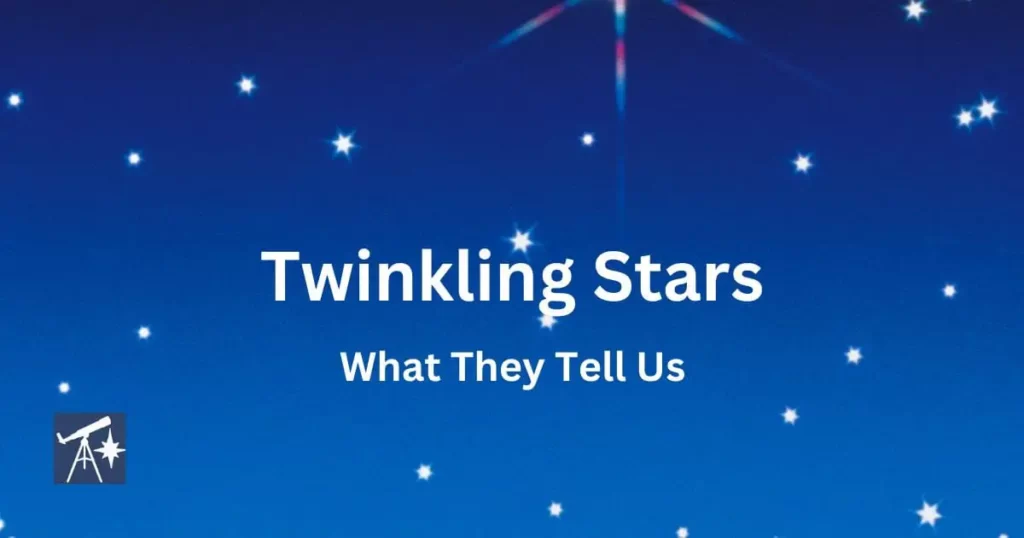
Why do stars twinkle? Stars appear to twinkle because of the atmospheric turbulence that’s everywhere blanketing the Earth, causing the pinpoint of light emitted by the star to flicker.
Stars twinkle because of turbulence in our atmospheric — different currents, temperature, and density between atmospheric layers.
These irregularities distort the starlight passing through, causing its brightness and color to vary.2
Scintillation is the scientific term for twinkling.
Do all stars twinkle? What is there to know as a backyard astronomer?
Much is written about this phenomenon from high authority sources, such as Nature journal.3
You may know the nursery rhyme, “Twinkle Twinkle Little Star”…

It started out as “The Star”, a poem penned by Jane Taylor and published in 1806.1 Together mother and baby are looking at stellar scintillation in the night sky with wonder. “How I wonder what you are.”
Here are the secrets behind the twinkle of stars and what it reveals for us backyard astronomers…
Twinkling stars and backyard astronomy
The twinkling of stars tells us some important stuff…like the sort of viewing experience we can expect. For example, I know now that…
- The best nights for using my telescope to look skyward is when the stars are ‘steady’, i.e., not scintillating (twinkling), but only occasionally winking, slow and at minimal frequency.
If I’m wanting to target close binary stars, these are the nights.
- They are also the nights to use my telescope for viewing fine details of planets. In other words… avoid the twinkling star nights.
It’s also called star shimmering. Alternatively, some describe the stars as ‘flickering’.
Through your optical lenses the image of the star will dance as a flash of light, change color and vary its brightness.
Star scintillation is a nuisance if you’re wanting the best experience through your telescope or binoculars. But there’s more…
Twinkling stars forecast the weather
Original people of different lands interpreted the twinkling of stars to forecast weather and conditions for hunting, fishing, or traveling.
This is how stars can be used to predict weather…
Twinkling and color changes in stars
Red stars appearing bluish indicates humid weather.
Rapid twinkling with blue tinge and fussy edges corresponds to a storm approaching.
Blue twinkling stars without color change meant clear hot weather for Torres Strait Islanders, as occurs in the hot-humid season of October to December in their part of the world.
For the same people, rapid twinkling stars with bluish look meant storms, as in the January to April in this southern hemisphere latitude.
When the wind drops while stars twinkle fast, it’s the best time for fishing.
The Wardaman people of north Australia read the twinkling of the star Canopus in dawn skies of September as the approach of the wet season.
Hawaiian navigators predicted weather and wind from twinkling stars.
The Maori people of New Zealand used Canopus as well.
For the Samoan people — a red star twinkling meant to them a cyclone was approaching. They forecasted moisture and turbulence from the jagged appearance at the edges. These edges resulted from changes in barometric pressure, temperature, moisture, and air currents that blurred and distorted the sharpness of the star seen from Earth.
The Fijian folk predicted the approach of the North East trade winds approaching from twinkling stars.
When planets twinkle
Planets scintillate, but you’ll only likely to see this when they’re at low altitudes (near the horizon) on nights of poor atmospheric conditions. Closer to the horizon, because of the angle, you’re looking through more of the thicker lower layers of the atmosphere.
The reason planets don’t otherwise twinkle like stars is because they are much closer to us than the stars we see in the sky and they appear bigger. They aren’t a concentrated point of light like we see with stars. Because of this the light they reflect from our Sun is not as easily disturbed by turbulence in our atmosphere.5
They [planets] are much bigger in apparent size… so the smearing out of their light is much less relative to the size of the planet itself. Since the image doesn’t jump around, they don’t appear to twinkle.
Phil Plait, PhD, astronomer, lecturer
Info sources
- Cunningham, John M. 2021. “Did Mozart Write “Twinkle, Twinkle, Little Star”?”. Encyclopedia Britannica. Accessed 27 February 2023.
- Ellison, M. A. 1952. Why Do Stars Twinkle? Journal of the Royal Astronomical Society of Canada, Vol. 46, p.191
- Gregory, C. The Scintillation of Stars. 1950. Nature 165, 146. https://doi.org/10.1038/165146a0
- Hamacher, D. W., Barsa J., Prassi S., & Tapin, A. 2019. Indigenous use of stellar scintillation to predict weather and seasonal change. Proceedings of the Royal Society of Victoria. 131(1) 24 – 33.
- West, A. 2012. Why Does Sirius Twinkle? phys.org. accessed 13 Mar 2023.
